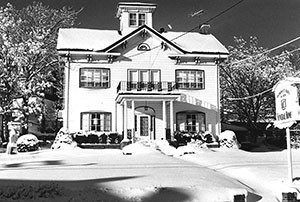
On February 19 the Historic Preservation Commission held a meeting, and 197 Washington St. was determined to be “preferably preserved.”
By Cathleen Twardzik
On February 19, the Historic Preservation Commission (HPC) held a meeting to discuss and determine the fate of the building now standing at 197 Washington St.
“The HPC determined the structure to be ‘preferably preserved’ on February 19, due to the scarce combination of specific architectural features and as the structure is well known to many residents in the city. The HPC determined, per Ordinance 2003 to 2005, Section 4.2.d, demolition of the building would be detrimental to the heritage of the city,” according to the Planning Department.
“The National Park Service identifies historic integrity as the ability of a property to convey significance. A property should possess sufficient integrity to convey, represent or contain the values and qualities for which it is judged significant. Therefore, the following is an identification and evaluation of these qualities and alterations as they affect the ability of the subject property to convey significance, location, materials, design and alterations are taken into account,” according to the Staff Report for Determination of Significance.
The structure was built in 1860, which proved to be a “transitional” time in Union Square. Those changes ranged from suburban to agricultural. Then, during the 1860s and 1870s, subdivision plans started to influence the residential neighborhood, which is currently situated in that area. 1933 marked the year in which that portion of Somerville was completely developed.
“The structure was built for Samuel W. Holt, a teamster. He also served on the Common Council from 1884 to 1885, as well as on the Board of Alderman from 1886 to 1887. In the early 20th century, William E. Plumer became the owner, and he had a hardware store at 52 Union Square. The structure is listed as “undertaker” on the 1933 Sanborn Map. However, Anthony Cota, the current owner, did not take ownership until the 1940s,” according to the planning department.
“The HPC determined the structure ‘Significant’ on January 15 due to an important association with Samuel Holt, as well as due to retention of the side-gable form, Italianate details such as deep eaves with double brackets, square cupola and center pediment with fanlight, original site plan. And since 1933, use of the building as a funeral parlor,” according to the Planning Department.
The HPC manages each request for demolition for each building which is greater than 50 years of age. The Demolition Review Ordinance does not eradicate the property owner’s right to destroy a construction. In fact, the HPC may simply postpone the demolition for a period of nine months. Throughout that time, the HPC will assist each applicant to conclude if another option, aside from a structure’s demolition, exists.















Reader Comments